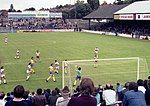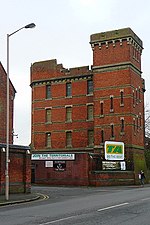Prospect Park, Reading
Country houses in BerkshireGrade II listed buildings in ReadingGrade II listed parks and gardens in BerkshireParks and open spaces in Reading, BerkshireTilehurst ... and 1 more
Use British English from February 2023

Prospect Park is a public park in the western suburbs of Reading situated north of the Bath Road in the English county of Berkshire. It is the largest and most popular park in Reading, and includes a large regency style house, now known as Prospect Park Mansion House and previously as Prospect House. There are also sporting facilities and the Prospect Park Miniature Railway within the 50 hectares (120 acres) of parkland, and a restaurant in the Mansion House.The park is listed as Grade II in the English Heritage Register of Historic Parks and Gardens whilst the Mansion House is a Grade II listed building.
Excerpt from the Wikipedia article Prospect Park, Reading (License: CC BY-SA 3.0, Authors, Images).Prospect Park, Reading
Tilehurst Road, Reading Dee Park
Geographical coordinates (GPS) Address Nearby Places Show on map
Geographical coordinates (GPS)
| Latitude | Longitude |
|---|---|
| N 51.44791 ° | E -1.00911 ° |
Address
Tilehurst Road
RG30 2NE Reading, Dee Park
England, United Kingdom
Open on Google Maps




